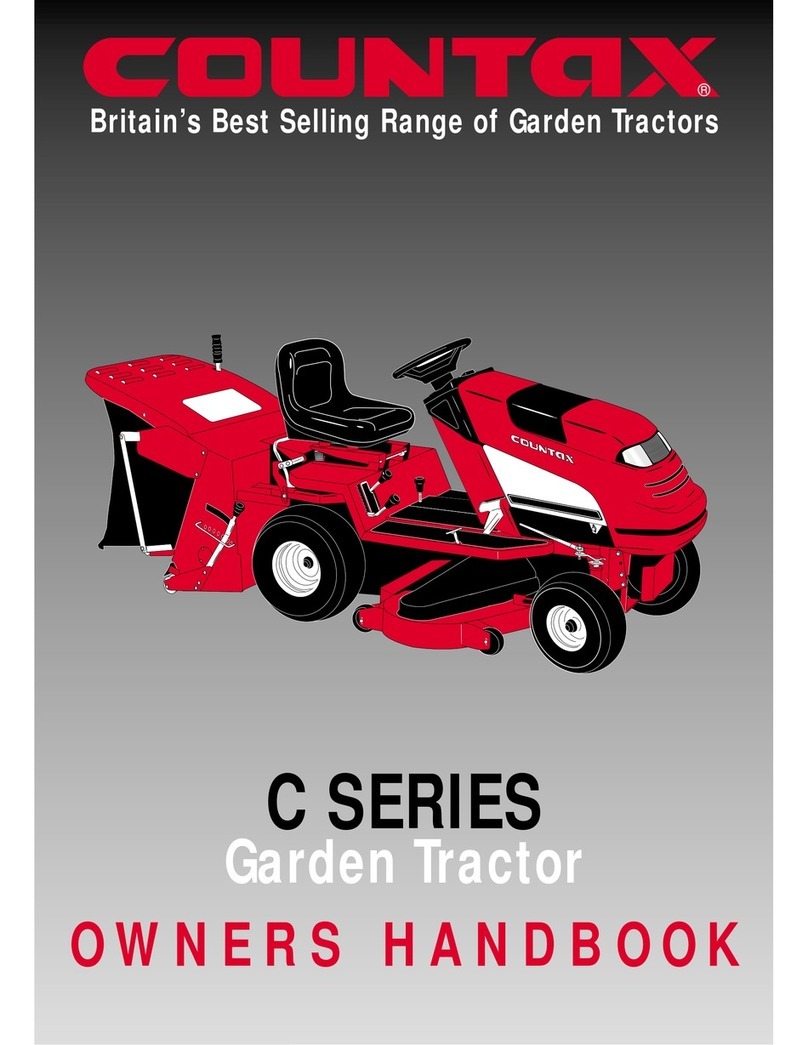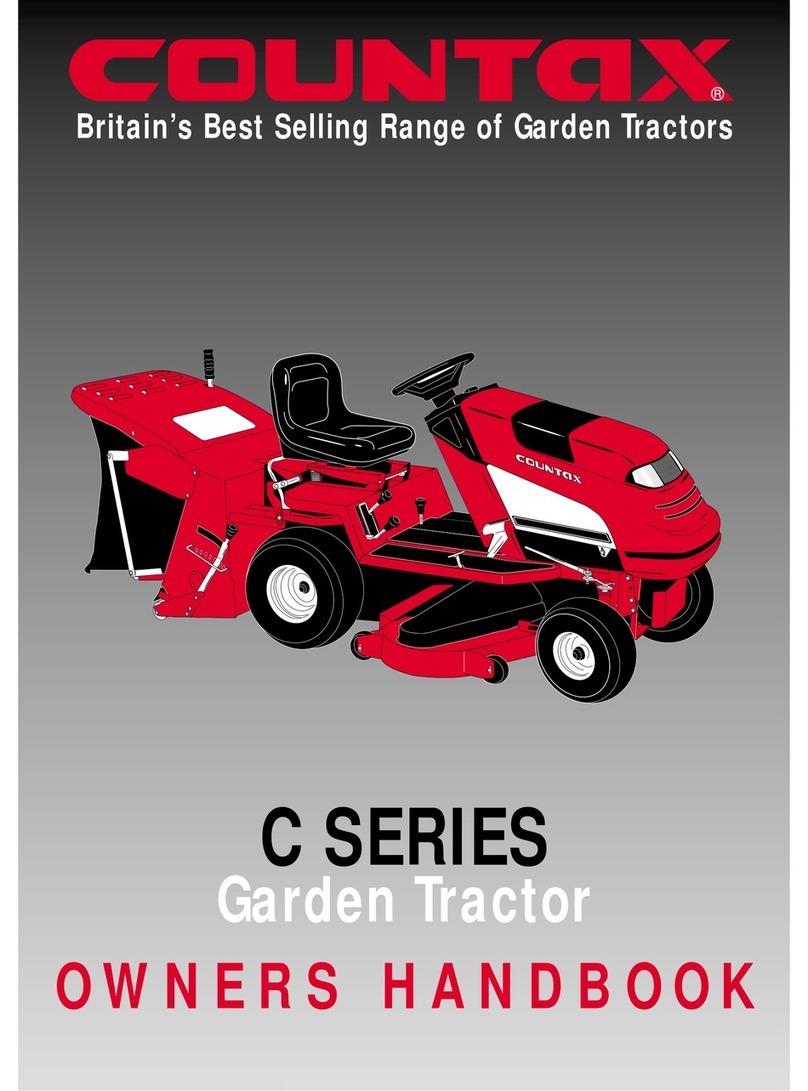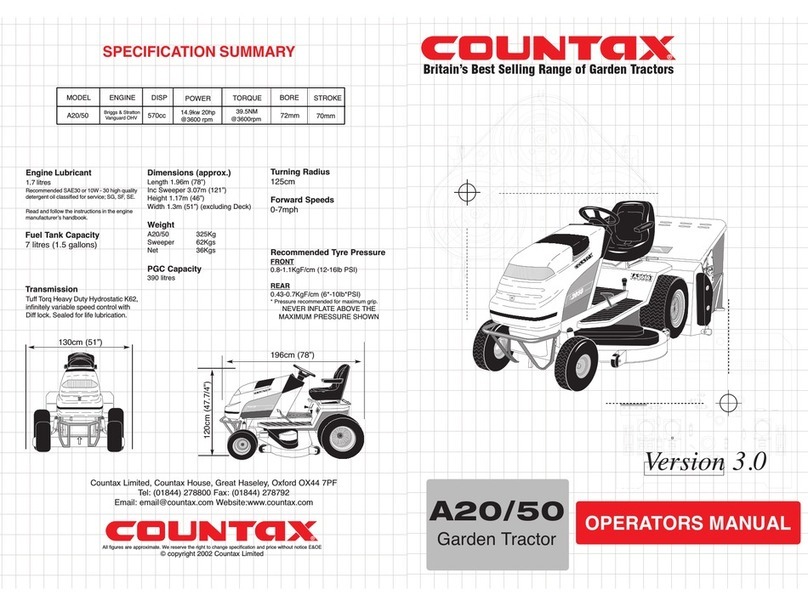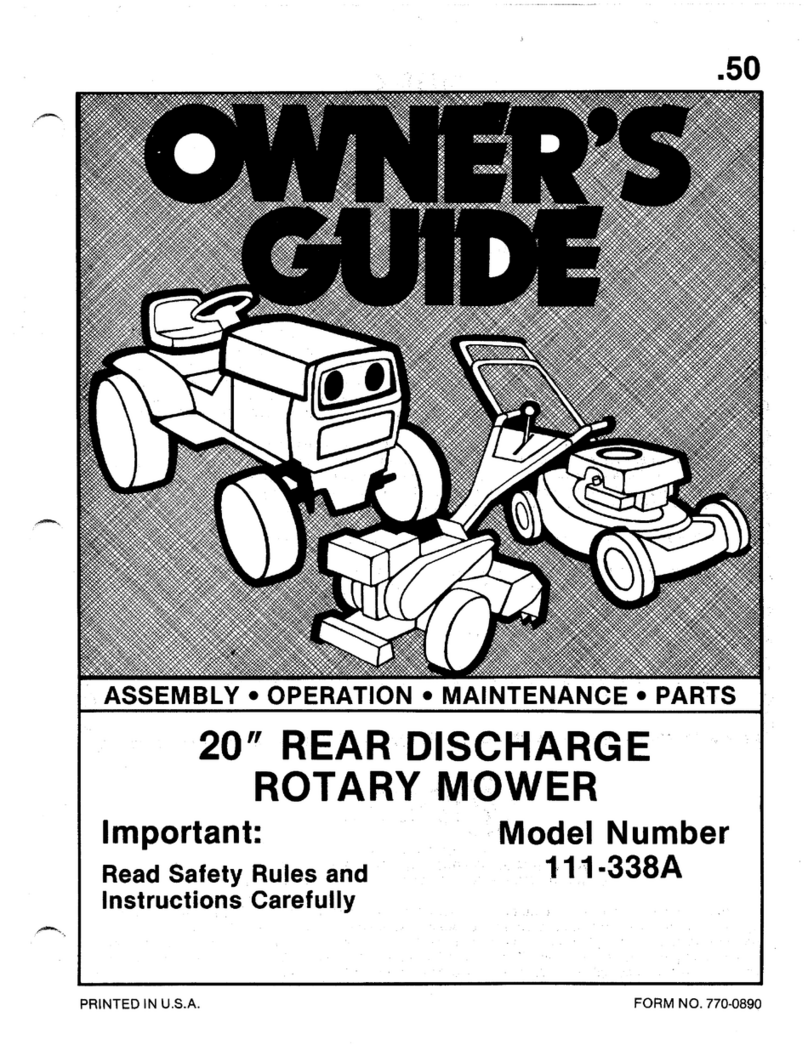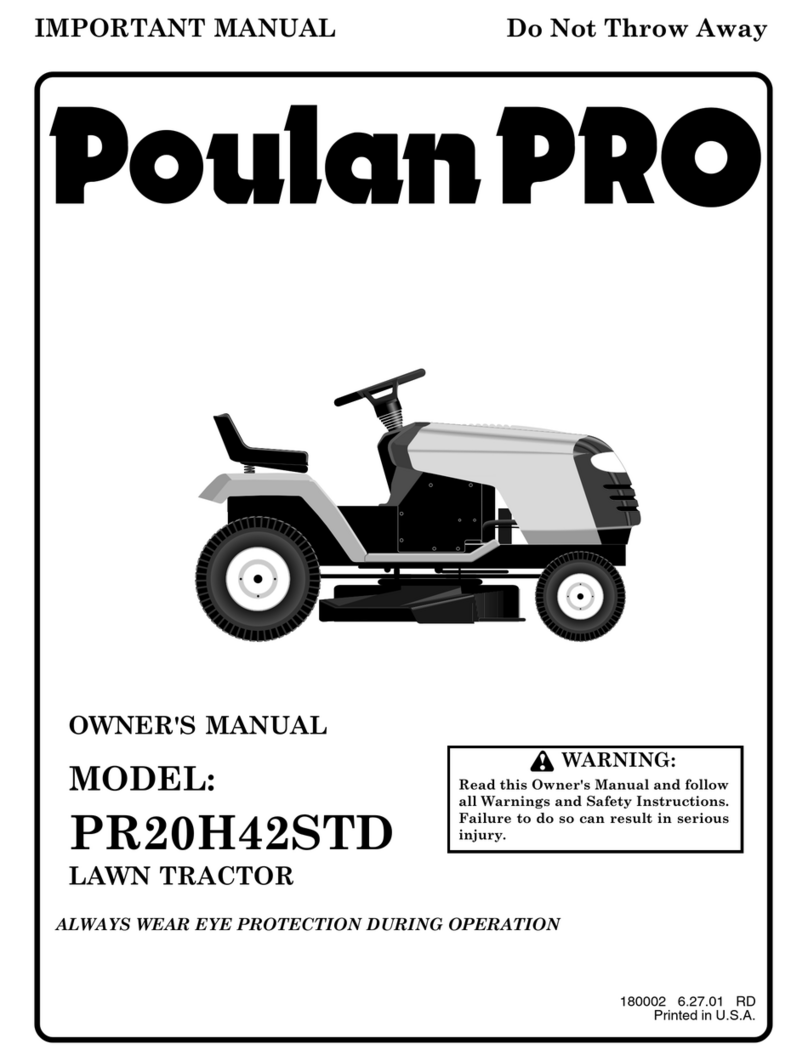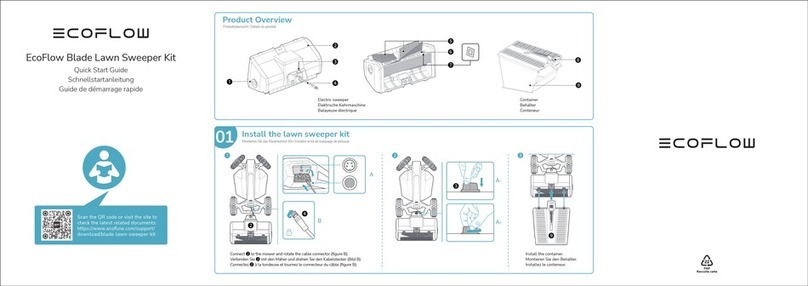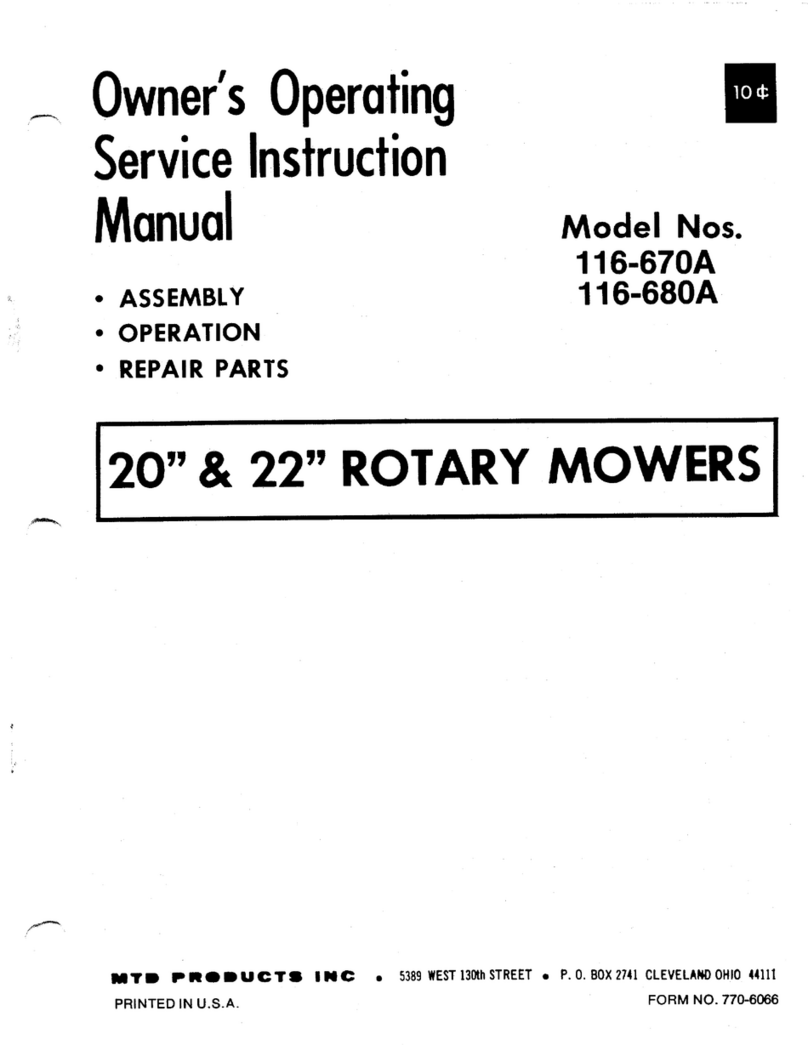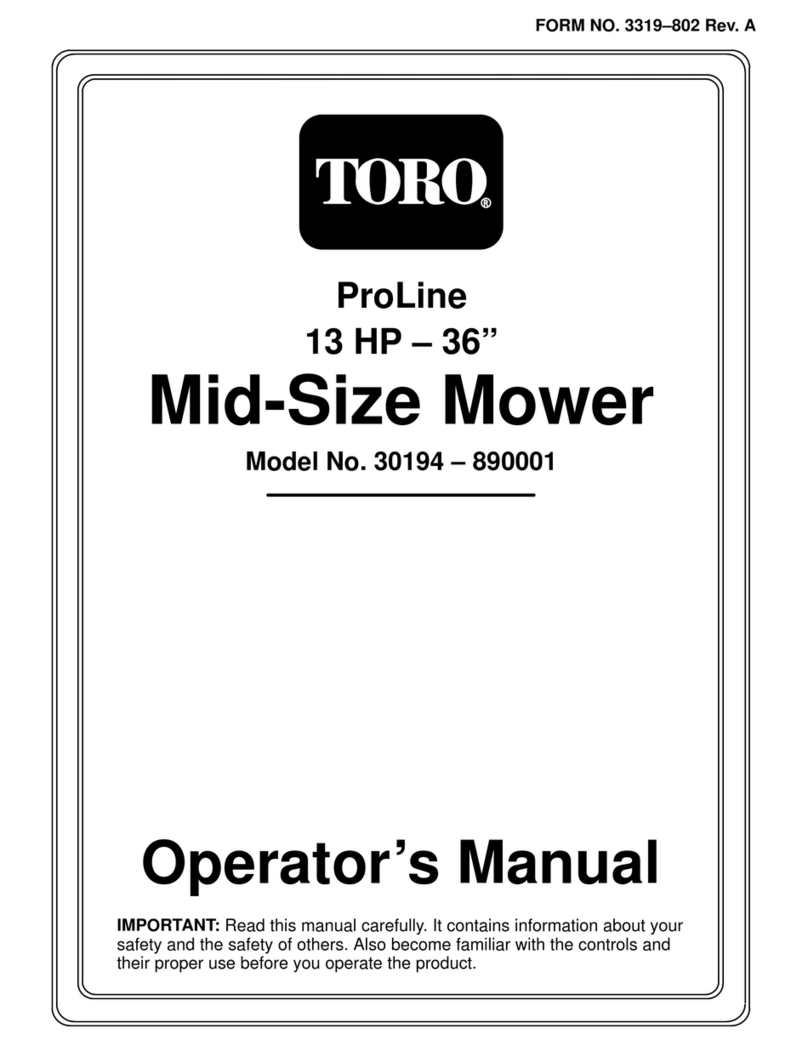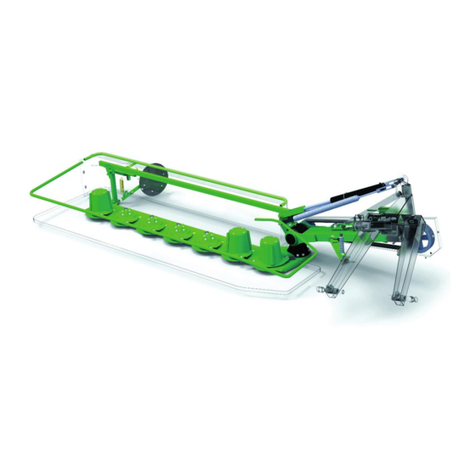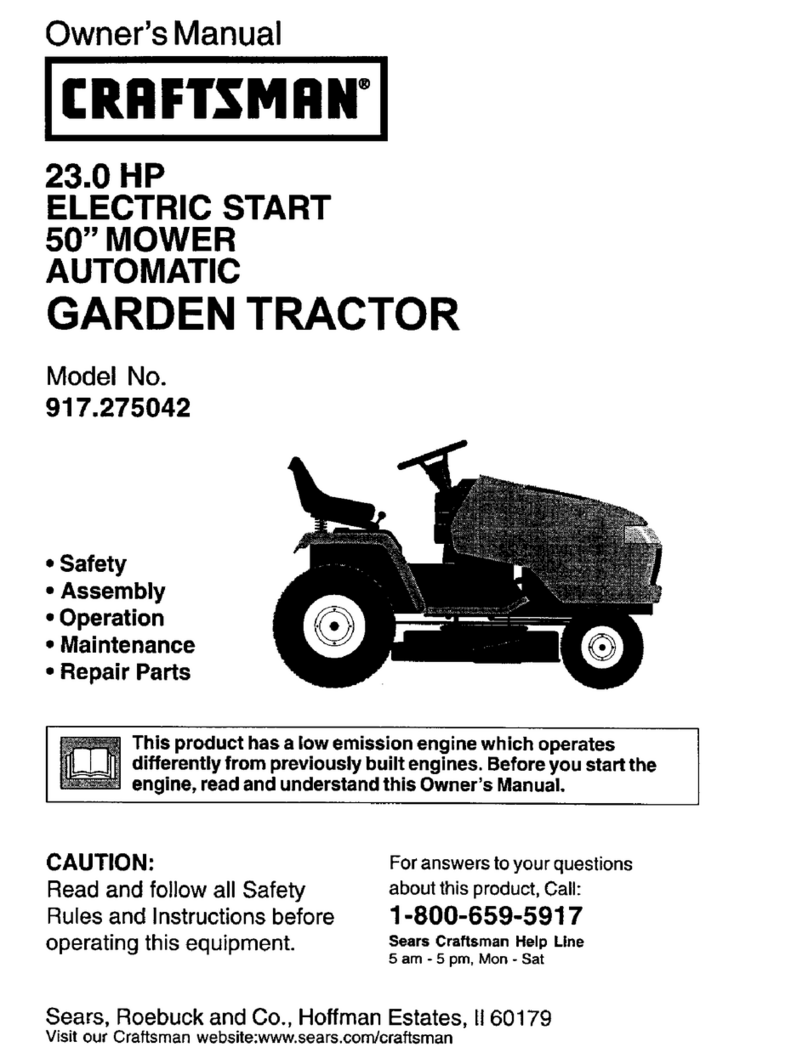Countax D18 User manual

OPERATORS MANUAL
D18/50
Manufacturers of Britain’s Best Selling Range of Garden Tractors and Rider Mowers
Version 1.1
Garden Tractor
TM
D
-DIESEL-

Page 2
Safety Instructions
MANDATORY SAFETY INSTRUCTIONS FOR
THE OPERATION OF GARDEN TRACTORS
1. Read the instructions carefully. Be familiar with the controls
and the use of equipment.
2. Never allow children or people unfamiliar with these
instructions to use the mower.
3. Never mow while people, especially children or pets
are nearby.
4. he operator or user is responsible for accidents or hazards
occurring to other people or their property.
5. Do not carry passengers.
6. All drivers should seek to obtain professional and practical
instruction. Such instruction should emphasise:
• he need for care and concentration when working with
this machine.
• Control of a tractor sliding on a slope will not be regained by
the application of the brake.
he main reasons for loss of control are:
• Insufficient wheel grip.
• Driving too fast.
• Inadequate braking.
• Incorrect load distribution.
1. Check that the machine complies with all applicable
regulations, including those in force when used on the public
highway.
2. When mowing always wear substantial footwear and long
trousers. Do not operate when barefoot or with open toe
sandals.
3. WARNING – Diesel is flammable:
• Store fuel in containers specifically designed for this purpose.
• Refuel outdoors only and do not smoke when refuelling.
• Add fuel before starting engine. Never remove the cap from
the fuel tank or add diesel while engine is running or when
engine is hot.
• If diesel is spilled, do not attempt to start engine but move the
machine away from the area of spillage and avoid creating a
source of ignition until diesel vapours have dissipated.
• Replace the fuel tank cap securely.
4. Replace faulty silencers.
5. Before using, always inspect to see that the blades, bolts and
cutter assembly are not worn or damaged.
TRAINING
MODEL D18/50
Power (K/w)
Max Rotation of blades (rpm)
Engine Manufacturer
Engine Type
Mass (Kg)
Max drawbar pull (Kg)
at coupling hook
Max vertical load (Kg)
Max sound power level
Vibration (m/s/s) hands:
Vibration (m/s/s) seat:
Type of cutting device
Width of cutting device
11.93
3100rpm
Yanmar
Diesel
290
650
on level ground
25
105 Db(A)
@ 3000rpm
2.05
0.53
Rotary
127cm
CERTIFICATE OF CONFORMITY
EC Declaration of Conformity
I, the undersigned R. Kilminster of Countax Limited,
Gt Haseley, Oxon. England, certify that lawnmowers:
Conforms to the specifications of Directive 8 /583/EEC (as adapted to the
technical progress by Directive 87/252/EEC and amended by Directive
88/180/EEC and Directive 89/392/EEC (amended by 91/368/EEC, 93/ /EEC
and 93/68/EEC) and Directive 89/336/EEC and amended by 91/263/EEC
92/31/EEC, 98/37/EEC
Standards used BS5107, EN292, ISO3767, ISO3789, ISO386
Tested at Oxford, England.
I declare that on behalf of Countax Limited these machines conform to EC
Essential Health and Safety Requirements
Signed:
R.Kilminster (Technical Director) 1/ /99
READ THE INSTRUCTION MANUAL BEFORE USING
THE GARDEN TRACTOR AND ENSURE THAT
OPERATORS STUDY IT FOR THEIR OWN SAFETY.
THE FOLLOWING PRECAUTIONS ARE OUTLINED TO
HELP PREVENT ACCIDENTS. A CAREFUL
OPERATOR WHO USES COMMON SENSE IS THE
SAFEST OPERATOR.
THESE SAFETY PRECAUTIONS ARE IN ADDITION TO
THOSE IN THE INSTRUCTION MANUAL.
Content Summary:
Safety Instructions Page 2,3
Controls and Indicators Page
Controls - Forward/Reverse Page 5
Controls - Levers & Dash lights Page 6
Cutting Decks Page 7
Cutter Deck - Removal Page 8
Cutter Deck - Check List Page 9
Deck levels - Front to Back Page 10
Cutter - Levelling Side to Side Page 11
Cutter - Drive Belt Page 12
Powered Collector Page 13
Collector - Adjustments Page 1
Collector - Drive Belts Page 15
Collector - Brush Page 16
Tyres and Wheels Page 17
Electrical Page 18
Engine - Oil and Oil Filter Page 19
Engine - Cooling Page 20
Engine - Fuel & Air Filter Page 21
Transmission - Oil Page 22
Notes Page 23
Controls
Cutter Decks
Collector
Engine

Page 3
Safety Instructions
6. Check the condition of the tyres and ensure that they are
inflated to the correct pressure (refer to the specifications on
the back page of this manual). his is particularly important if
the machine is to be taken on the public highway.
7. Check the mower is in good working order, paying particular
attention to brakes and steering.
8. Check that all linkages, connections, and pivot nuts are secure
and that the wheel nuts are torqued correctly.
OPERATION
1. Do not operate the engine in a confined space where
dangerous fumes can collect.
2. Mow only in daylight or in good artificial light.
3. Before starting the engine, disengage blade and attachment
drives and ensure your feet are off all pedals.
4. ake care on slopes of more than 10º incline or decline
(maximum safe operation is at 15º).
5. Remember that there is no such thing as a ‘safe’ slope. ravel
on grass slopes requires particular care to guard against
overturning:
• Do not stop or start suddenly when going up or downhill.
• Machine speed should be kept low on slopes and in tight turns.
• Stay alert for humps and hollows and other hidden hazards.
• Avoid mowing across the face of the slope.
6. Watch for traffic when crossing or near roadways.
7. Stop the blades rotating before crossing surfaces other
than grass.
8. When using the machine, never direct discharge of material
towards bystanders or allow anyone near the machine while
in operation.
9. Never operate the mower with defective guards, shields or
without safety protective devices in place and in good
working order.
10. Do not change governor settings to increase the revs of the
engine. Operating the engine at excessive speed increases the
hazard of injury.
11. Before leaving the operators position:
• Disengage the drive to the cutter blades and attachments and
lower the attachments.
• Remove your foot from drive pedals and set the handbrake.
• Stop the engine and remove the key.
12. Disengage drive attachments, stop the engine and remove
ignition key before:
• Clearing blockages.
• Checking, cleaning or working on the mower.
• Refuelling.
• Removing the grass catcher.
• After striking a foreign object (inspect the mower for damage
and make repairs before restarting the tractor).
• If the machine starts to vibrate abnormally check immediately
and call dealer if necessary.
13. Disengage drive to attachments when transporting or
not in use.
14. Reduce the throttle setting during engine run-out.
15. Never work on the mower when the engine is running.
MAINTENANCE AND STORAGE
1. Check that all nuts, bolts and screws are tight to be sure the
equipment is in a safe working condition.
2. Allow the engine to cool before storing in any enclosure.
3. o reduce the risk of fire keep the engine, silencer and battery
compartment free of grass, leaves, petrol or excessive grease.
4. Check the grass catcher frequently for wear and tear or
deterioration.
5. Replace worn or damaged parts for safety.
6. If the fuel tank has to be drained, this should be done outdoors.
7. Be careful during adjustment of the machine to prevent
entrapment of fingers between moving blades and fixed
parts of the machine.
8. Do not use steam cleaners or high-pressure washers directly
towards the bearings or electrical components (Countax do not
recommend the use of these power cleaners). Incorrect use
could void warranty.
SUPPLEMENTARY INSTRUCTIONS FOR THE
USE OF COUNTAX D18/50 TRACTOR
1. Use good sense at all times and to ensure this tractor is safe
and serviceable, fit only original manufacturers
supplied spares.
2. When inspecting the area to be cut, note also the position of
any stumps, manhole covers, bumps and depressions and
avoid them to prevent damaging the blades.
3. We recommend the use of standard diesel and that you ensure
the fuel tank is full before you start the machine.
4. Always disconnect both battery terminals before attempting
any work in the engine compartment.
5. Do not leave the tractor unattended and running.
6. Do not put hands near moving belts or the Power ake-Off
pulley while it is rotating.
SAFETY SWITCHES
SEAT SAFETY SWITCH
Your Countax tractor is fitted with a switch that will turn OFF the
engine and the cutter deck should you dismount.
This is a afety back-up and should not be used voluntarily. If
you want to dismount from the tractor and want the engine to
continue running, first switch OFF the cutter deck, then apply
the parking brake. You can now dismount. DO NOT LEAVE
THE ENGINE IDLING FOR ANY LENGTH OF TIME. Should
you try and dismount with the parking brake ON, the cutter deck
will cut out after a short delay of a couple of seconds. Do not
rely on this back up cutout. Ensure safety by switching the
cutter deck off.
PARK BRAKE SAFETY SWITCH
Your Countax tractor is fitted with a safety switch activated by
the Park Brake lever. This switch earths the ignition unless the
brake is on. The engine will only start while the brake is
engaged. Two red lights on the dash (Ignition, and Brake)
indicate that the engine is ready to start.
N.B Both afety witche work on the fuel cut-out olenoid.
Should afety witche be activated, to re- tart the tractor -
the ignition witch hould be turned compleately off.

red
yellow
green
Page
Controls & In icators - Dashboard
O
O
Cutter
Engage Switch Light
Switch
Ignition
Switch
Deck
Height Switch
PGC Net
Empty Switch
Auxiliary
Lift Switch
IGNITION
he ‘Key Start’ controls both the ignition and the starter. Insert
the key and turn to the first position, the dash lights will come on
(check that all is ready to start). For starting from cold, turn the
key to the secon ‘heat’ position and hold for 10 seconds. urn
the key further to the thir position to crank the engine, release
the key as soon as the engine is running and it will return back to
the first position. If the tractor is to be started from a hot engine,
pre-heating is not required.
CUTTER ON/OFF SWITCH
he cutter switch controls the Electromagnetic Blade Clutch. It
works like a light switch (but in reverse) – UP for ON and
DOWN for OFF. Although it always returns to the central
position and the cutter deck will automatically be turned off
when the engine is switched off, it is not good practice to rely on
this. he cutter deck should always be switched OFF as soon as
you have finished cutting and certainly BEFORE stopping the
engine or getting off the tractor.
ENGINE SPEED CONTROL
he lever is pushed forward and up for high revs, back and down
for low. Please note, when in use the engine speed should be set
to maximum revs.
HEADLIGHT SWITCH
Switching the rocker switch turns ON the headlights. he
headlights will not operate when the ignition is OFF. urn the
headlights OFF before starting or stopping.
WARNING LIGHTS (fig 2)
1). Situated above the PGC net emptying switch are three
warning lights. he first (re ) light is a charge light. his light
will illuminate when the key is turned to the first position, when
the engine is started the light will go out. If the light comes on
whilst the engine is running consult your dealer.
2). he second (yellow) light is a ‘high water temperature’
warning light. his light will only come on if the water
temperature becomes too high. Should this occur, stop the engine
straight away and allow to cool. When the engine has cooled,
check the water level in the radiator (see page 20) and top up
coolant as required. If the light stays illuminated – call your
dealer immediately.
3). he third (green) light is an ‘oil pressure’ warning light. his
light will come on when the key switch is turned to the first
position, and then go out when the engine is running. If the light
illuminates whilst the tractor is in use – stop the engine
immediately and contact your dealer before attempting to restart
your machine.
O
1
2
3
fig 2
fig 1
Engine
Speed
Warning
Lights

Page 5
Controls - Forward/Reverse
FOOTPEDAL CONTROLS / MOVING OFF (fig 1,2)
o move off, ensure your foot is off the pedals ‘A’ and ‘B’ then
disengage the parking brake by moving lever ‘C’ (fig 2) forward.
Now gently depress either pedal ‘A’ or ‘B’ (fig 1) to move off
forward or backward. he function of either pedal has the same
effect as the accelerator on a car except that it controls the
hydrostatic transmission and does not effect the speed of the
engine. N.B. he engine speed must be set to maximum
whenever the tractor is used. Never attempt to depress pedal ‘A’
and ‘B’ together as damage to the linkage may occur which will
not be covered by warranty.
REVERSING (fig 1)
o engage and control reversing simply take your foot off pedal
‘A’ – to avoid a rapid stop remove your foot gently. he tractor
will come to a standstill. When the tractor is stationary, depress
pedal ‘B’ to move backwards.
PARKING (fig 2)
Remove your foot from pedal ‘A’ and ‘B’ and the tractor will
come to a standstill. Now engage the park brake by simply
moving lever ‘C’ (fig 2) rearward to an upright position- you will
feel the lever lock into this position.
EMERGENCY BRAKING (fig 1,2)
In case of an emergency remove your foot from the drive pedal
simultaneously engaging park brake lever ‘C’. he tractor will
stop abruptly.
DIFFERENTIAL LOCK (fig 3)
he D18/50 is fitted with a differential lock for maximum
traction on slopes and slippery ground. he differential lock
should only be used in situations where one wheel is slipping and
the other is not. In a situation when one wheel starts to slip and
extra traction is required simply depress pedal ‘D’ (fig 3) and the
differential will lock both wheels to drive at the same speed. As
soon as the differential lock is not required release the engage
pedal ‘D’ and as soon as the wheels are rotating at the same speed
and not under load (i.e. on a slope) the lock will automatically
release.
WARNING: Do not attempt to steer the tractor
when the ifferential lock is engage . Always
ensure the ifferential lock is release before
manoeuvring in a close area.
HYDROSTATIC BYPASS VALVE (fig 4)
o push or freewheel the D18/50, release the park brake then
disengage the hydrostatic transmission by releasing the bypass
valve. Simply pull the bypass valve lever ‘E’ (fig 4) outward.
You will now be able to push the tractor. Reset the bypass valve
by pushing the lever in BEFORE starting the tractor.
fig 1
fig 2
fig 3
fig
On no account
attempt to operate
either forward or
rever e pedal whil t
Parking brake i
engaged. Thi will
re ult in damage that
will not be covered by
warranty
Park Brake
Released
Park Brake
‘On’
A
B
C
E
D
Engaged
Position
Hydrostatic
Bypass
Lever

Page 6
Controls - Levers & Dashlights
POWER TAKE-OFF (PTO) fig 1
Lift the lever to the LEFT and DOWN, letting it find its own
height to engage the P O and UP and to the RIGHT to
disengage (fig 1). his is an ON/OFF lever for the P O. Always
have this lever in the DISENGAGED POSITION when it is not
in use. Do not put hands near moving pulleys and belts.
ELECTRIC LIFTS
he cutting height is adjusted by pressing a rocker switch (A) on
the left of the dash panel (fig 4) UP for higher or DOWN for
lower. An illuminated indicator on the dash will show the
position and 10 indicated heights are shown for guidance
purposes only – the cutting height is in fact infinitely adjustable!
o get the best from this refinement use it to continuously adjust
cutting height to suit ground and grass conditions. Do not make
downward adjustments on the move until you are familiar with
this height control to avoid scalping.
PGC NET EMPTY SWITCH (fig 3)
A third switch is fitted to those tractors with a Powered Grass
Collector. his switch empties the collector net via an electric
actuator mechanism that lifts the grass box and pushes out the
bottom pan, fully emptying the collector contents. Press the
switch UP to open and DOWN to close the net (fig 3).
SEAT ADJUSTMENT
he seat on the D18/50 is adjustable forwards and rearwards to
suit the operator. Simply lift the seat latch at the front of the seat
(fig 2) and slide the seat forwards or backwards to suit. Always
ensure the seat is latched back into position before driving off.
A
DE
C
B
(A) ‘Cutter On’ indicator flashes continuously when cutter is
running.
(B) he ‘Ignition On’ indicator goes out when the cutter
is running.
(C) he ‘Brake On’ indicator.
(D) he ‘Deck Height’ indicator.
(E) he ‘Hour Meter’.
O
O
O
-D1850-
IMPORTANT - READ SAFETY INSTRUCTIONS BEFORE OPERATING THIS MACHINE
MULCHING
For Best results;
- Do not reduce the height of the grass by more than 1/3 in a single pass
- Mow often - short clippings of 25mm (1") or less decompose more quickly
- If possible, avoid cutting in the wet
- Always cut with the engine at full running speed
- If an unsightly residue is present - increase cutting height
- Vary mowing pattern from cut to cut
- Always keep the underside of the deck clean to permit good grass flow
- Always ensure that blades are sharp and in good condition
VIBRATION TESTED TO THE FOLLOWING STANDARDS
BS 6842:1987, DD ENV 25349:1993, SI 1992:3073, BS6841:1987
15 MAX
O15 MAX
EXERCISE CAUTION WHEN CUTTING
ON SLOPES
PTO
fig 1
fig 2
fig 3
fig
Deck Height
Switch
Seat
Adjustment Latch
Power
Take-off Lever
Dashlights
PGC Net
Empty Switch

Page 7
Cutting Decks
fig 1
fig 2
fig 3
fig
MULCH MOWING
Mulching can save time, avoids gathering piles of rotting
cuttings and feeds your lawn. It is however necessary to observe
certain rules to mulch mow successfully:
• Reduce the height in each pass. If the grass has grown long
make several passes to achieve the cut height you require.
• Always cut with the throttle set to FAS – mulching needs the
full running speed of the engine.
• Mow often, particularly in spring and early summer. Short
clippings of 25mm (1") or less decompose more quickly.
• If possible avoid cutting in the wet.
• If an unsightly residue of cuttings is being left – increase the
cutting height.
• Vary the mowing pattern from cut to cut.
• Always keep the underside of the cutting deck clean to ensure
good grass flow.
• Always check that the blades are sharp and in good condition
– but do not attempt to sharpen or replace them yourself. New
Countax blades are not expensive and it is good practice to ask
your dealer to change them regularly.
REAR DISCHARGE DECK
he Countax IBS Rear Discharge deck in contrast to the Mulch
Deck, finely cuts the grass and then ejects it rearwards where it is
collected by the Powered Grass Collector. his system offers the
benefit of the ‘striped lawn’ finish to your garden and tidies loose
leaves and garden debris from your lawn.
Specified Belts and Blades
Part No.
Part:
Engine/Deck Belt -
Dayco Super II B56 (Mulcher) 22871200
Deck Internal Drive (Mulcher)
BB112 228000900
Deck Internal Drive (IBS)
BB155 22950200
Mulcher Blades x3 16938100
IBS RH Blade 169381300
IBS LH Blade 169381400
PGC Drive Belt A47 22898000
PTO Drive Belt - Dayco IIA98 22950100
Transmission Drive Belts A98
Dayco Super II 2295000
Engine/Deck Belt -
Dayco Super II B57 (IBS) 22940100
Remember - only use specified Belts
and Blades. Never accept a substitute!
Mulch Deck
Pulley
Arrangement
Mulch Deck
Blade
Arrangement
IBS Deck
Pulley
Arrangement
Mulching
Process

Page 8
Cutter Deck - Removal
Either the Mulch Deck or the Rear Discharge Deck can be fitted
to the D18/50 using the following instructions:
REMOVAL OF CUTTER DECK
he cutter deck can be quickly removed for servicing or cleaning
or to give greater clearance when driving or towing over uneven
ground.
Follow this sequence:
1. Put the cutter to the lowest position (see page 6).
2. De-tension the cutter drive belt with the lever situated under
the left (nearside) running board (fig 6).
3. Remove the 3 securing pins from the front of the deck
(fig 3 – A, B and C) by pulling out the spring clips.
4. Remove the 2 securing pins from the back of the deck
(fig 2 – D and E).
5. Slip the cutter drive belt off the engine pulley.
6. Slide the deck out.
7. If you are going to use the tractor without the deck, remove the
securing bar (F).
When replacing the cutter deck, re-tension the belt with the lever
under the running board. hen check the belt tension (page 12).
TO CLEAN CUTTER DECK
Remove the deck as instructed, stand it on its side and hose off
accumulated cuttings. his may be necessary routinely to prevent
build-up of cuttings particularly at the beginning of the season
when the grass is lush and wet. horoughly wash the underside
of the cutter deck as regularly as possible.
ENGINE TO CUTTER DRIVE BELT
REPLACEMENT
Follow this sequence:
1. Pull the belt tension lever (fig 6) forward.
2. Lower the cutter deck to the lowest position.
3. Remove the cutter deck as described above.
4. Remove belt guard, loosen the two M8 set screws using
using a 13mm spanner and socket.
5. Remove the belt from the pulley and fit replacement.
6. Refit the belt guard ensuring that it is clear of the belt
and pulley.
7. Refit the cutter deck to the tractor and re-tension the deck
drive belt as described on page 12.
CF
ABF
fig 1
fig 2
fig 3
fig fig 5
fig 6
Unsecured Secured
De-tensioned
Position
Actuator Tensioned
Position
i
The belts fitte to your tractor are of a special
construction an belt tensions have been precisely
set in the factory. If you un ertake to replace a belt
yourself you must be VERY careful that the
correct Countax supplie belt is use an that the
tension is set accurately.
-Use only genuine Countax parts-
B
A
E
D
D
E
C

i
Page 9
Cutter Deck - Check List
CUTTER FAILS TO START OR CUTS OUT
WHEN SWITCHED ON
Check:
• Are you on the tractor? – Unless you sit on the seat the safety
switch cuts out the cutter deck.
• Is the battery low? - he clutch engage switch will only
operate if the battery is well charged.
• Does the 10Amp barrel fuse on the printed circuit board need
replacing?
• hat either the cutter switch or the safety switch on the seat is
not faulty – if so, call your dealer.
UNEVEN CUT (CUTS SHORTER ONE SIDE
THAN THE OTHER)
Check:
• hat the tyres are all inflated to the correct pressures
(see back page).
• hat the front axle is pivoting freely.
• hat the deck suspension brackets are moving freely and
hitching up.
• hat the side to side deck level adjustment is correct
(see page 11).
CUT IS UNEVEN OR UNTIDY IN ONE OR
MORE SECTORS
Check:
• hat the cutter deck is levelled correctly front to back
(see page 10).
• hat one or more of the blades are not worn or damaged – if
so, call your dealer.
THE CUTTER SEEMS TO LOSE POWER AND
THE BELT SLIPS AND OVERHEATS
Check:
• hat the tensioner is correctly applied.
• hat the cutter belt tension is correct (page 12).
• hat the cutter deck is not clogged with wet cuttings.
• hat the cutter drive belt is not worn.
fig 1 fig 2
fig 3
fig
fig 5
Cutter is not level side to side Cutter is not level side to side
Cutter is not level front to back (tipped forward)
Cutter is not level front to back (tipped back)
Individual cutter blades damaged or bent
Remember:
Correct levelling of your deck i vital to en ure the
be t cutting performance from your D18/50.
If you are in doubt a to whether your cutter deck
require levelling, con ult your local
Countax dealer.

Page 10
Deck Levels - Front to Back
he cutter deck should be set so that it is parallel to the surface it
is cutting with a maximum variation from side to side, or front to
back of 3mm. Check this by placing the tractor on a hard level
surface and measuring the clearance heights front to back and
side to side with a steel ruler or tape with the cutter set one
adjustment from its lowest position (see page 6).
If the cutter deck seems to require levelling first check these
other possible causes:
1. Are the tyres inflated to the correct pressure all round – if not,
inflate to the correct pressures as specified on the back page.
2. Are the cutter deck hanger brackets (fig 2) moving freely. o
check this lift the cutter deck to its highest position and lift and
rock it, watching to ensure that the brackets move freely – if
not clean and grease.
3. Is the front axle pivoting freely? – If not, clean and grease.
4. Is there any impact damage that has bent or distorted the deck
suspension brackets (a matter for your dealer).
5. Is the cutter deck drive belt tensioned correctly?
If the deck is still uneven: -
LEVELLING FRONT TO BACK
(You need two people for this operation – one to lift the deck
while the other removes or relocated the runnion)
1. Ensure that all the anti-scalp wheels are all adjusted in the
same hole – if not, rectify (fig 3).
2. Lower the cutter deck to a position one above the lowest
setting – check levels with a ruler or tape.
3. Now locate the front to back adjustment rod to the right offside
of the cutter. At the rear end of this rod you will find the
runnion (fig 2) that links the rod to the deck hanger bracket.
Both the runnion and the rod are threaded and adjustment is
achieved by rotating the runnion to shorten or lengthen
the rod.
4. o free the runnion use a 9/16" spanner or socket to remove
the 3/8" Nyloc nut and washer and push it free.
5. Rotate the runnion to advance it up the rod to lift the back of
the deck. Rotate it the other way to lift the front. Adjustment is
rapid so try one or two turns and relocate the runnion bracket
and secure – then check the effect. Repeat and re-check if
necessary.
fig 1
Tool Required
Steel Rule or Tape
9/16” AF Socket
1/2” Spanner
1/2” Socket
13mm Spanner
13mm Socket
Rever ible Ratchet
12” Exten ion Bar
fig 2
fig 3
Anti-Scalp
Wheels
Adjustment
Holes
Deck Hanger
Bracket
Trunnion
Front to Back
Adjustment Rod

Page 11
Cutter - Levelling ide to ide
LEVELLING SIDE TO SIDE
Adjustment is best done with the deck in a position one up from
its lowest cut – check the level both sides and levelling is then
achieved by adjusting the left (nearside) of the deck at two
points:
REAR ADJUSTMENT
1. Find the deck level disk (fig 1) near the back nearside wheel.
underneath the actuator lifting arm. his disk has a concentric
slot in which the deck-levelling rod is located.
2. Using a 1/2" spanner, loosen the 5/16" Nyloc nut Asecuring
this stud just enough to permit some movement.
3. Now lift or lower the deck depending on the adjustment you
wish to achieve. his will move the stud up or down the disk B
– the higher up and nearer the centre of the disk the higher
the deck.
4. Check with your ruler or tape and having levelled the deck at
the rear, re-tighten the Nyloc nut.
FRONT ADJUSTMENT
1. Having levelled the rear of the deck, check if the front is level.
If not, you will need to find the deck adjustment plate (fig 3)
which is forward of the cutter deck near the front
(nearside) wheel.
2. Before making adjustments loosen the two sets of nuts and
bolts (Aand B) securing the deck levelling bracket (C) using a
13mm spanner and 13mm socket.
3. hen using a 13mm spanner, loosen (upper) locknut (D).
4. Now adjust the height by using a ratchet or spanner to turn the
Nyloc nut (E) clockwise (up) to raise the deck or anti-
clockwise (down) to lower it.
5. When level is achieved tighten up all nuts and bolts except E.
For the closest cut, set the anti-scalp wheels in the middle
adjustment holes. If you are experiencing scalping this can be
minimised by setting the wheels in the lowest adjustment holes.
Tool Required
Steel Rule or Tape
9/16” AF Socket
1/2” Spanner
1/2” Socket
13mm Spanner
13mm Socket
Rever ible Ratchet
12” Exten ion Bar
fig 2
fig 1
fig 3
Deck
Level Disk
A
A
B
i
Plea e note:
Unless caused by our negligence, Countax
cannot accept any liability for any damage to
persons or property attributable to failure to
comply with the instructions in this manual. To
be absolutely sure that your warranty terms are
not breached, service work should only be
carried out by a Countax dealer.
D
E
C
B
Deck Level Disk
located underneath actuator
Deck
Levelling
Bracket

Page 12
Cutter - Drive Belt
Before carrying out tests or adjustments (the problem may be
simpler) – first CHECK the following points:
1. Is the engine to cutter drive belt slipping? Check that the drive
belt tension lever (fig 1) under the left running board is in the
rear (tensioned) position. If not, rectify – this is the most likely
cause.
2. Has debris collected in the cutter deck pulley housing
(page 9)? If so remove the cover and remove the obstruction.
ENGINE TO CUTTER DRIVE BELT TENSION
he correct tension of the cutter drive belt (engine to deck) is
critical. If incorrectly set it can lead to engine damage.
To check the tension, follow this proce ure:
1. Put the deck in a middle cutting height (position 5 on the HE
illuminated indicator).
2. Select a midway position on the belt between the front
(electric clutch) pulley and the rear (cutter deck) pulley and
using a spring balance; apply a 2Kg (4 to 5lbs) pull (fig 3).
3. Using a ruler or tape, measure the deflection achieved which
must be 13mm (1/2"). If more, the belt tension must be
increased, if less – decreased.
To correct the tension, follow this proce ure:
1. Release the tension on the belt by pulling the belt tension lever
forward (see fig 1).
2. aking care not to burn yourself on the hot exhaust, locate the
runnion at the end of the belt tension rod – lift the bonnet and
look at the front (nearside) close to the exhaust.
3. Remove the spring clip and washer holding the runnion in
place on the deck tension cradle (fig 2) and release the
runnion so it can be turned.
4. Both the runnion and the belt tension rod are threaded. You
increase belt tension by winding the runnion towards the end
of the rod and reduce tension by winding in the reverse
direction.
5. Having made the adjustment re-locate and secure the
runnion, re-tension the belt with the belt tension lever – then
re-check the belt tension.
Deck Tension
Cradle
Deck Tension
Rod
Trunnion
Washer
Spring Clip
Kg
cm
Specified Belts and Blades
Part No.
Part:
Engine/Deck Belt -
Dayco Super II B56 (Mulcher) 22871200
Deck Internal Drive (Mulcher)
BB112 228000900
Deck Internal Drive (IBS)
BB155 22950200
Mulcher Blades x3 16938100
IBS RH Blade 169381300
IBS LH Blade 169381 00
PGC Drive Belt A 7 22898000
PTO Drive Belt - Dayco II A98 22950100
Transmission Drive Belts A98
Dayco Super II 2295000
Engine/Deck Belt -
Dayco Super II B57 (IBS) 229 0100
-WARNING-
On no account must
the tractor be run with
the engine to cutter
drive belt over-
tensioned as it will
damage the engine.
As any such damage
will not be covered by
your warranty you
may prefer that your
dealer sets the
tension.
fig 2
fig 3
fig 1
De-tensioned
Position
Actuator Tensioned
Position
Deck
Tension Lever
Deck
Tension Cradle

Page 13
Powere Collector
CONNECTION
o connect the Powered Grass Collector (PGC) to the D18/50
tractor, ensure both are on an even surface with the locking
levers (fig 3) on the collector facing the lift arms of the tractor.
Move the collector manually to the tractor. Lower the lift arms
using the auxiliary lift switch button (page 4) on the dash
console.
At the end of each lift arm you will find a locating lug. Slide the
channels on either side of the PGC over the lugs but do not
engage the locating lever yet. Ensure that the rubber flap at the
opening of the PGC located on top of the transmission grass
deflector.
INSTALLING THE DRIVE BELT
Place the drive belt over the P O pulley (beneath the tractor
seat). Standing adjacent to the tractor, extend the belt with both
hands parallel to the ground. Now twist the belt to form a figure
‘8’ – the right hand up and the left hand down. In this position
place the other end of the belt over the Powered Collector pulley.
Be sure that this is installed the right way round otherwise the
brush will work in reverse and collection will be poor! Lock
locating lever (fig 3) over the lift arm lugs. Rotate the locking
clips over lift arm lugs. Connect net empty plug to socket as
shown in fig 1. o disconnect, reverse this procedure.
PTO DRIVE BELT TENSION
Engaging the locating lever tensions the belt which should not be
run too tight – to check the tension there should be a 19mm
deflection with light finger pressure (2Kgs) at a midway point
between P O pulley and sweeper pulley. It is important after
attaching the sweeper to the tractor to check the belt tension and
adjust this if necessary this must be done before the sweeper is
put into operation and with the sweeper on the ground. With light
finger pressure, 2Kgs (4lbs) there should be a total deflection of
19mm (3/4") at midway point between P O pulley and the
sweeper pulley. If a spring balance is available a pressure of 4-
5lbs (1.81-2.26Kgs) is required for a deflection of 3/4" (19mm).
If the belt tension is incorrect, it can be adjusted by movement of
sweeper locking levers on the threaded rod. Ensure the lock nuts
are suitably tightened after adjustment. N.B. Do not over-tighten
lock nuts as lever needs to pivot.
TO USE: raise sweeper to transport position. A button on the left
hand side of the console (page 4) raises the Powered Collector to
the transport position. We recommend that you drive to and from
the area to be swept with the Powered Collector in this transport
position and with the P O disengaged. When you reach the area
to be swept, lower the collector and then engage the brushes by
pushing the sprung P O lever to the left to release and engage.
LOWER THE COLLECTOR
Using the Auxiliary lift switch on the dash, lower the collector.
REMOVE THE NET
When removing the net, we suggest you employ the assistance of
another person.
1. Partially open the Sweeper net (100mm(4")). Disconnect
opening rod by pulling back on sprung locking tube and
uncoupling from pin (fig 2).
2. Repeat either side.
3. Undo net locking clip (both sides), unhook levers from
locating pins (see fig 2).
4. With either person standing each side of the collector net, slide
the net off the locating arms.
5. Reverse operation for fitting.
fig 1
fig 2
fig 3
Net Locking
Clips
Pin
Locating
Pins
Locking
Tube
Opening
Rod
Locating
Lever
Locking
Clips
Lifting
Arm
Locating
Arms
Net Empty
Socket
Locating
Lug

Page 1
Collector - Adjustments
ADJUST THE SWEEPING HEIGHT
Using the Sweeping height lever (fig 2) select the position
appropriate to the conditions and the height of the cut. O GE
HE BES SWEEPING PERFORMANCE AND O
PRESERVE HE BRUSHES SELEC HE HIGHES
SE ING HA WORKS – start high and adjust down until the
brushes stop to collect. DO NO SE HE BRUSHES OO
LOW – this will lead to scarifying and a very untidy finish as
well as shortening brush life.
CHECK LIST
Not picking up satisfactorily – check:
1. hat the P O lever is engaged.
2. hat P O pulley beneath the seat is turning – if not call
your dealer.
3. hat the Collector Belt is not reversed (if it is correct the brush
will revolve against the forward direction of the tractor -
see below).
4. hat the brush height adjustment is not too high or too low –
start at the highest setting and lower until it begins to collect.
5. hat there is not a build up of congealed grass on the leading
edge on the brush guard.
6. hat the brush is not clogged.
7. hat the collector brush is not slipping – if so:
• Adjust tension (see page 15)
• Or replace worn or damaged belt (see page 15)
8. hat the collector net is not clogged. If so, wash or brush with
a stiff hand brush.
9. hat the bristles are not damaged (if so you can replace
individual comb bristles or fit a complete new brush
(see page 17).
10. hat the ventilation slots on the top of the collector box are
not clogged.
11. hat the venturi air vent is not blocked.
TO TIP CUTTINGS
You can check the contents of the grass box through the clear
cover. When it is full raise the collector to the transport position.
Drive to your tipping area; reverse to the pile, select neutral then
depress the PGC net empty switch (see page 4 fig 1).
fig 1
fig 2
Sweeping
Height Lever
Ventilation
Slots
Correct
Rotation

Page 15
Collector - Drive Belts
REPLACING AND TENSIONING PTO DRIVE
BELT CONNECTION
It is important that the belt from P O to collector (Part No.
22950100) is crossed over in the correct direction (fig 1) before
being fitted over the collector pulley. he easiest way to do this is
to place the belt on the P O pulley and then stand behind the
tractor holding the belt with two hands. urn the right hand
above the left and fit the belt on to the collector pulley.
o check that you have this right - start your tractor and engage
the P O lever and check that the brush is revolving against the
forward direction of the tractor (see page 14 fig 1).
CORRECT BELT TENSION
o check tension:
1. Lower the collector to the operating position and check the
tension using a spring balance.
2. Select a place on the belt midway between the P O pulley and
the collector pulley.
3. Pull and measure the deflection using a ruler (fig 2). It should
be 19mm at 2Kgs (4-5lbs).
If the tension needs to be adjusted – first:
1. Relocate the Collector from the tractor.
2. Locate the adjustment holes on the Locking Arms. hese holes
take the nuts and bolts on which the locking arm hinges.
3. o increase tension on the belt undo each nut and bolt and
relocate them one or more holes forward (towards the tractor).
o slacken move the bolts back, ideally the bolts should be in
the same hole on each locking arm, however fine adjustment
to get the right tension may only permit you to move one bolt
– this is OK but there should not be more than one hole
difference from side to side.
4. Replace the collector on the tractor and re-check the belt
tension.
CHECKING, TENSIONING AND REPLACING
SIDE DRIVE BELT (fig 3)
1. First remove collector from the tractor (page 13).
2. o remove the plastic cover, remove the two nuts and bolts (A)
using a 1/2" spanner and socket.
3. Using a 1/2" spanner and socket slacken the nut and bolt (B)
holding the tension pulley and slide the pulley out of the way.
4. Remove the belt and fit the Countax replacement (Dayco
Super II A38 Part No. 229503000).
5. ension the belt by sliding back and securing the belt
tensioner. he tension is not critical but the belt must not be
too tight. he ideal is 13mm (1/2") deflection at 2Kgs (4/5lbs)
pull – use a spring balance and ruler or tape to check.
6. Make sure that the rectangular cover plate fits over the
adjustment slot – failure to do this will allow cuttings and grit
to accumulate and damage the pulleys and belt assembly.
7. Replace the plastic cover.
Kg
cm
A
B
fig 1
fig 2
fig 3
i
Plea e note:
Unless caused by our negligence, Countax
cannot accept any liability for any damage to
persons or property attributable to failure to
comply with the instructions in this manual. To
be absolutely sure that your warranty terms are
not breached, service work should only be
carried out by a Countax dealer.
19mm deflection 2kgs push or pull
To Slacken To Tighten
Check tension using
a spring balance and
ruler or tape
Side
Drive Belt
Locking
Arm
19mm

Page 16
Collector - Brush
If the brush has become worn or damaged it is simple to replace
the whole brush assembly or individual bristles.
TO REMOVE THE BRUSH STOCK
1. Remove the grass bag assembly by lifting it off the pivot
brackets.
2. Detach the collector from the tractor.
3. Locate the 1/4" nut and bolt at each end of the brush and undo
and remove using a 1/6" spanner and socket. Keep safely
taking care not to lose the washers.
4. Now remove the cover mouldings and free the brush stock.
5. You can now slide off the brush bosses which each hold three
brushes. Note their position on the brush stock (fig 1) which
must alternate when you return them.
6. Slide out and replace individual brushes where necessary and
then re-assemble.
7. When you replace the cover mouldings note that the holes to
take the spindles are off centre and are located at the furthest
end of the brush stock.
Note: This edge should be regularly wiped
and kept clean to ensure that grass cuttings
do not build up and solidify imparing the
grass discharge and causing damage
to the brushes.
Brush Boss
Nyloc Nut
Washer
Washer
Bolt
Brush Stock
Brush
Brush Drive
Moulding Bottom
Brush Drive
Moulding Top
Sweeper
Slinger

Page 17
Tyres an Wheels
Countax tractors are fitted with grassland tyres that are designed
to present a large area to the ground for grip; and are soft profile
to prevent marking your turf. hey are of thicker section and
tougher than most 4 ply tyres.
Persistent punctures and tyre deflation are nevertheless a
problem experienced by about 5% of Countax customers. his is
not a problem just for Countax owners - it is shared by the users
of all types of off-road machinery fitted with pneumatic tyres. In
practically every case there is one common cause – HORNS!
Blackthorn, Hawthorn, and Rose are usually at the bottom of it
and will puncture any tyre not fitted with very expensive guards.
here are less expensive ways to overcome this problem.
Check an avoi these possible causes:
1. he rim of the wheel has become damaged – breaking the seal
on the tubeless tyre. here are two possible solutions:
• If the damage is not severe, treat with Countax tyre sealant
(Pt No. 52903501)
• If the damage is significant – order a new wheel
Front wheel – (Pt No.198000500)
Rear wheel – (Pt No. 198000700)
2. You have Hawthorn, Blackthorn or Wild Rose in your hedges
– these will puncture any tyre. It makes sense to check the area
you intend to cut or drive over and to remove any branches.
he long-term solution is to treat all four tyres with Countax
tyre sealant – follow the instructions on the bottle.
If your tyres spin or lose grip check:
1. Are the tyres inflated to the correct pressures, check
back page?
2. Are you driving too fast for the conditions? If so, select a
slower speed.
REMOVAL OF FRONT WHEEL
1. Apply the parking brake.
2. Place chocks under all wheels that are to remain on the
ground.
3. Remove the hubcap.
4. Use a 3/4" (19mm) socket spanner and ratchet to slacken off
the wheel nut – do not remove.
5. Place jack under the front axle (fig 1) and jack up until the
wheel to be removed is well clear of the ground.
6. Remove the nut and washer and keep it safe,
7. Pull off the wheel carefully AKING CARE NO O
DISLODGE HE RAC OR FROM HE JACK.
When the tyre is repaired replace the wheel preferably using a
new 12mm Nyloc nut, Part No. 049381100.
REMOVAL OF REAR WHEEL
1. Apply the parking brake.
2. Place chocks under wheels that are to remain on the ground.
3. Place the jack under the ransaxle (see fig 2) and raise until
the wheel is well off the ground.
4. Undo the four 19mm (3/4”) nuts using socket and wrench.
5. Pull off the wheel carefully AKING CARE NO O
DISLODGE HE RAC OR FROM HE JACK.
6. Reverse instructions to complete the job making sure to
tighten wheel nuts (to torque – 68NM/50ftlbs).
i
-Warning-
Never jack the tractor up by jacking under the running
board. We do not advice owner repair puncture .
It i be t to take the wheel to your local tyre
peciali t or u e Countax tyre ealant.
fig 1
fig 2
fig 3 fig
Front
Jacking Point
Rear Jacking
Point
Front
Wheel Rear
Wheel

Page 18
Electrical
FUSES AND SHORTS
here are 5 fuses on the D18/50 tractor. he 20Amp (yellow)
charging circuit, the mid positioned 20Amp (yellow) lights,
ignition and safety switches. he 20Amp (yellow) electric lift for
cutter deck and auxiliary lift. he forth 20Amp fuse is connected
in line for the net emptying system.
o check – remove fuse and check small window, there should be
an unbroken metal strip bridging the gap (fig 2).
Note – If the 20Amp (centre) fuse blows when the ignition key is
turned this means there is a short between the red and blue
coloured wire and the body of the tractor. he usual places to
investigate are:
• he electrical P O and socket.
• Seat switch wires.
• he brake micro switch.
If fuses blow after these areas have been checked call
your dealer.
PRINTED CIRCUIT BOARD
here are 2x10Amp Barrel fuses on the circuit board (fig 3)
which can be reached by removing the cover (fig 1). hese two
fuses control lights and the Electromagnetic Blade Clutch. If the
problem is not a fuse and you cannot see any loose connections –
call your dealer.
ELECTROMAGNETIC BLADE CLUTCH
If the blade clutch disengages without being switched off these
are the possible causes:
• You have got off the seat – the safety switch will disengage
the cutter.
• he battery has lost charge and will not longer hold the clutch
in operation.
• Fuse blown on printed circuit board – see fig 3.
• Faulty safety switch or break in wire – see your dealer.
fig 1
fig 2
fig 3 PRINTED CIRCUIT BOARD
10Amp
Cartridge Fuse for
Electric Clutch
Deck Height
Indicator (located on
the other side of PCB)
Hour Meter (located
on the other side of
the PCB)
10Amp Cartridge
Fuse for LIghts
10
10
PCB located
under the
dashboard
Main fuse
30 amp
i
-Plea e Note-
Countax recommend that any electrical problem you
may have with your tractor be dealt with by your
upplying dealer. If owner choo e to undertake
ervice work them elve they do o at their own ri k.
Countax accept NO re pon ibility for any damage
thu cau ed whether or not the in truction have
been mi under tood
Fuse
location

Page 19
Engine - Oil and Oil Filter
LUBRICATION OIL INSPECTION AND REFILL
Always check the engine oil before starting the tractor.
Ensure the tractor is on an even level surface when inspecting or
refilling oil. o check oil levels, follow this procedure:
• Clean around dipstick to prevent debris from falling into the
crankcase and damaging your engine.
• Remove dipstick and wipe off any oil with a clean lint
free cloth.
• Install the dipstick back into the tube, but DO NO tighten.
Let the dipstick threads rest on top of the tube.
• Remove the dipstick and examine the marked area for the
highest point of oil. he oil level should be between the upper
and lower limit lines on the dipstick.
If the oil level is low then top up to the required level using a
good grade 15w30 Diesel engine oil. Remember, overfilling
beyond the upper limit level can be just as damaging to your
engine as running the tractor without any oil. Fill with small
amounts of oil at a time and then recheck and top up if necessary.
CAU ION – After refilling, wipe off any spilled oil and tighten
the oil filler cap securely.
OIL CHANGE (fig 2)
Change the oil in your D18/50 after the first 50 hours of use, then
every 200 hours thereafter. Drain the oil while it is still warm
after running (having allowed the engine to cool enough as to not
scold). Warm oil drains quicker and more cleanly than cold.
o change the oil, follow this procedure:
• Remove the drain plug and drain oil.
• After draining oil, tighten the drain plug securely.
• Fill with fresh oil to the specified level.
• Run the engine at no-load for about 5 minutes and check the
oil level again about 5 minutes later and top up if low.
ENGINE OIL FILTER REPLACEMENT(fig 3)
Change the oil filter after the first 50 hours of use, then after
every 200 hours of use. Always ensure oil and filter have
sufficiently cooled before attempting to replace the filter. o
replace the oil filter in your D18/50, follow this procedure:
• When removing the engine oil filter, hold the bottom of the
filter mount with a piece of rag to prevent the oil
from dripping.
• Use a filter wrench to loosen and remove oil filter.
• Clean the oil filter mount surface on the cylinder block.
• Apply clean engine oil to the new O-ring for the oil filter.
• Fully tighten the oil filter to the mount surface, then tighten it
about three quarters of a turn using the filter wrench.
OIL FILTER PART No. 11930535150
MAX
MIN
fig 3
fig 2
fig 1
Loosen
Tighten
Oil
Dipstick
Oil Filter
replacement
Engine
Oil Drain
Check that oil
level is within
these two marks

i
Page 20
Engine - Cooling
COOLANT LEVEL
he coolant level should be checked daily as a matter of routine.
ONLY EVER INSPEC COOLAN WHEN HE ENGINE IS
COMPLE ELY COLD. o check level, follow this procedure:
• Check the coolant level in the sub-tank. If the level is close to
the lower limit, remove the sub-tank cap and fill with coolant
to the upper limit.
• Remove the radiator cap and check the amount of coolant in
the radiator. Fill with coolant to the overflow if the level
is low.
Check the difference of the cooling water level before and after
operation once a week. Before operation when the engine is cold
there should be a low level of coolant. Immediately after
operation (when the engine is hot) there should be a high level of
coolant. If there is no difference in coolant level before and after
the engine operation open the radiator cap and check the coolant
volume. Also check the hose linking the radiator and the sub tank
to make sure that it is not disconnected, loosened or torn. Check
that the hose is inserted to the lower level of the sub-tank (when
engine is cold).
COOLING WATER REPLACEMENT
- CAUTION -
Change the cooling water when the engine is fully col to
prevent scal ing. Never open the ra iator cap whilst the
engine is hot, this may result in scal ing steam an a
hot water blow-out.
o change coolant, follow this procedure:
• Position a can to collect the waste fluid.
• urn the radiator cap anti-clockwise for 90º without pressing it
downward.
• Press the cap downward and continue to turn it anti-clockwise
to remove. If forcibly turned the cap may become damaged.
• Disconnect the hose between the coolant pump and the
radiator out of the cooling pump side. When the coolant is
fully drained, reconnect the coolant rubber hose.
• Add coolant whilst bleeding air by pinching or tapping the
coolant rubber hose.
• Fill coolant to the upper limit of the sub tank.
• Operate the engine at no-load for about 5 minutes and check
for any fluid leakage.
• Check the sub-tank coolant level about 5 minutes after
stopping engine and replenish as required.
T
I
G
H
T
E
N
R
E
M
O
V
E
S
L
O
W
L
Y
LOW
FULL
fig 1
fig 2
fig 3 Check coolant
level by examining
the sub-tank. The
Liquid should be
visible through the
white plastic tank.
Radiator
Cap
Radiator
Filling
Sub-Tank
This manual suits for next models
1
Table of contents
Other Countax Lawn Mower manuals
Popular Lawn Mower manuals by other brands

Toro
Toro 70082 Operator's manual
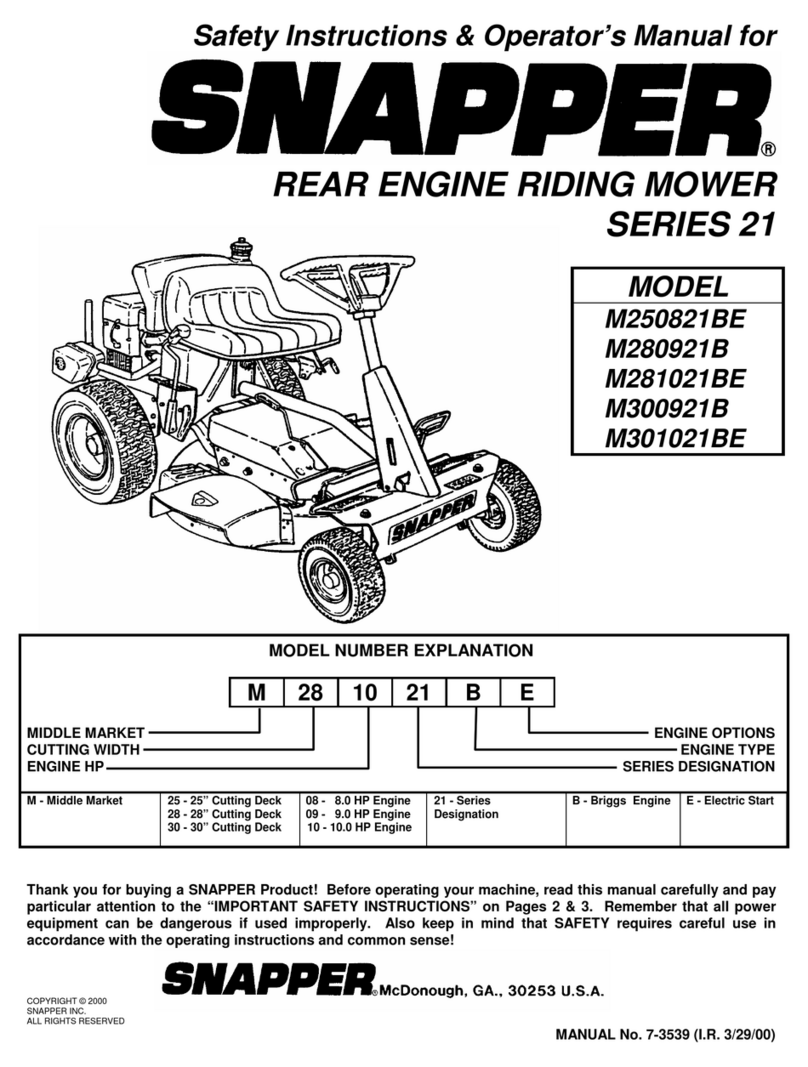
Snapper
Snapper M250821BE, M280921B, M281021BE Safety instructions & operator's manual
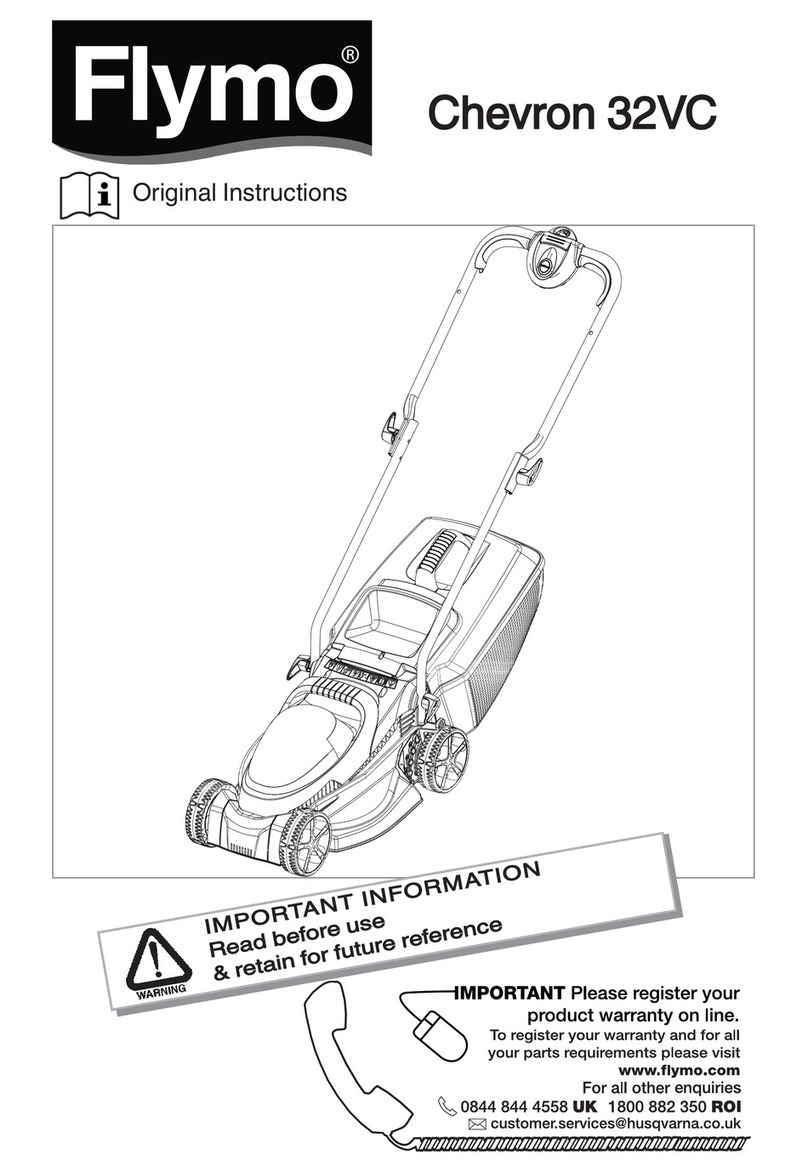
Flymo
Flymo Chevron 32VC operating instructions

Gravely
Gravely 915015 1742 9150156 2048 Owner's/operator's manual
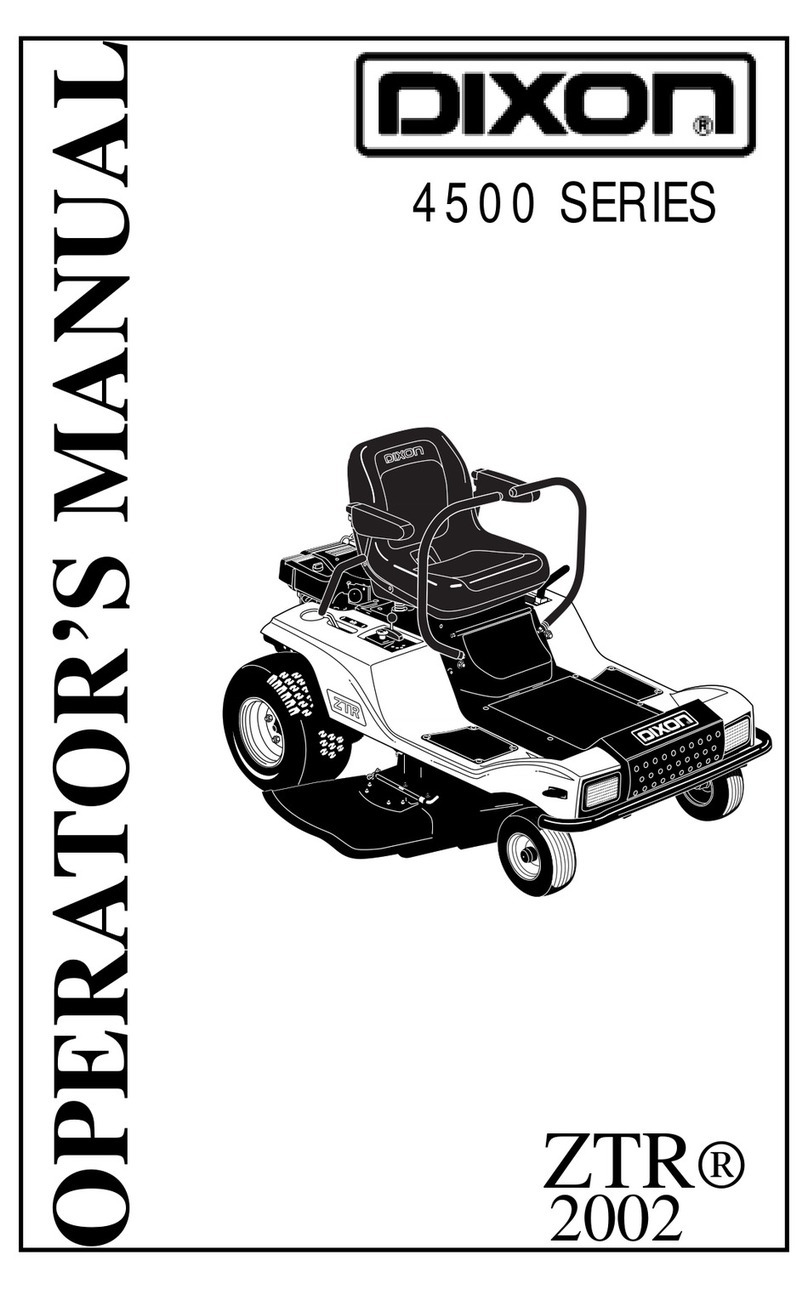
Dixon
Dixon Zeeter Classic ZTR 2002 Operator's manual
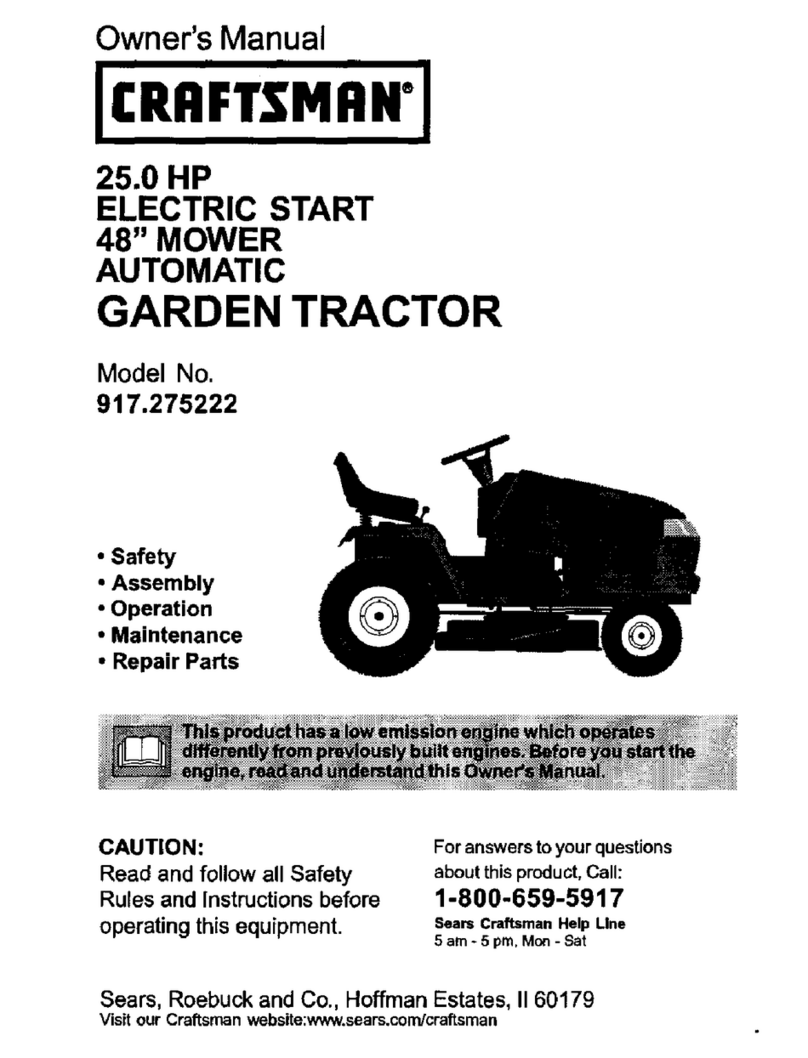
Craftsman
Craftsman 917.275222 owner's manual

